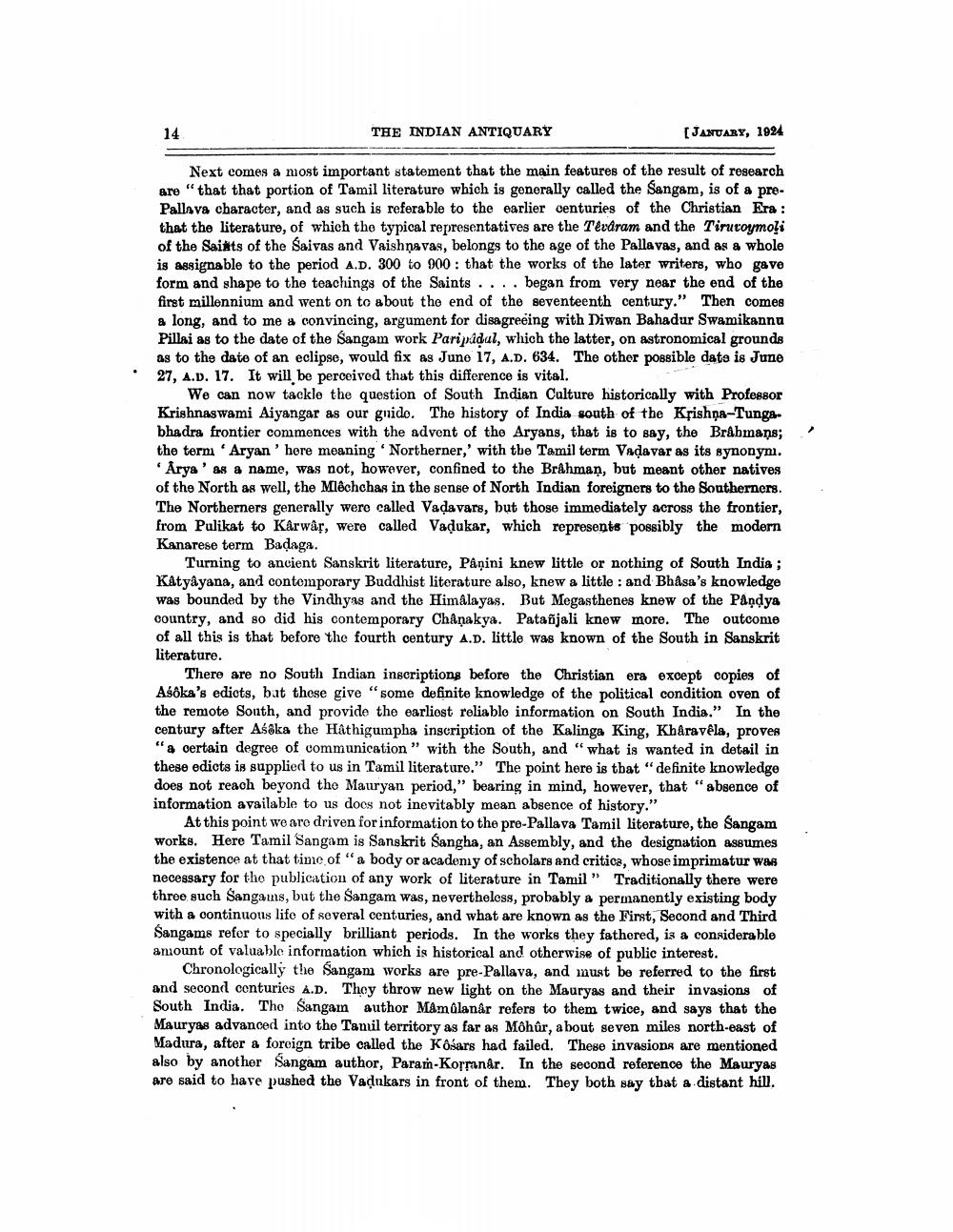________________
14
THE INDIAN ANTIQUARY
[JANUARY, 1924
Next comes a most important statement that the main features of the result of research are " that that portion of Tamil literature which is generally called the Sangam, is of a prePallava character, and as such is referable to the earlier centuries of the Christian Era : that the literature, of which the typical representatives are the Térdram and the Tirucoymoli of the Saints of the Saivas and Vaishnavas, belongs to the age of the Pallaves, and as a whole is assignable to the period A.D. 300 to 900 : that the works of the later writers, who gave form and shape to the teachings of the Saints . . . . began from very near the end of the first millennium and went on to about the end of the seventeenth century." Then comes a long, and to me a convincing, argument for disagreeing with Diwan Bahadur Swamikannu Pillai as to the date of the Sangam work Paripadal, which the latter, on astronomical grounds as to the date of an eclipse, would fix as June 17, A.D. 634. The other possible date is June 27, A.D. 17. It will be perceived that this difference is vital.
We can now tackle the question of South Indian Culture historically with Professor Krishnaswami Aiyangar as our guide. The history of India south of the Krishna-Tungabhadra frontier commences with the advent of the Aryans, that is to say, the Bråbmans; the term 'Aryan' here meaning Northerner,' with the Tamil term Vadavar as its synonym.
Arya ' as a name, was not, however, confined to the Brahman, but meant other natives of the North as well, the Mléchchas in the sense of North Indian foreigners to the Southerners. The Northerners generally were called Vadavars, but those immediately across the frontier, from Pulikat to Karwar, were called Vadukar, which represents possibly the modern Kanarese term Badaga.
Turning to ancient Sanskrit literature, Påņini knew little or nothing of South India; Katyayana, and contemporary Buddhist literature also, knew a little : and Bhâsa's knowledge was bounded by the Vindhyas and the Himalayas. But Megasthenes knew of the Pandya country, and so did his contemporary Chanakya. Patañjali knew more. The outcome of all this is that before the fourth century A.D. little was known of the South in Sanskrit literature.
There are no South Indian inscriptions before the Christian era except copies of Asoka's edicts, but these give "some definite knowledge of the political condition oven of the remote South, and provide the earliost reliable information on South India." In the century after Asaka the Hathigumpha inscription of the Kalinga King, Khára vêla, proven "a certain degree of communication" with the South, and "what is wanted in detail in these edicts is supplied to us in Tamil literature." The point here is that "definite knowledge does not reach beyond tho Mauryan period," bearing in mind, however, that "absence of information available to us does not inevitably mean absence of history."
At this point we are driven for information to the pre-Pallava Tamil literature, the Sangam works. Here Tamil Sangam is Sanskrit Sangha, an Assembly, and the designation assumes the existence at that time of "a body or academy of scholars and critics, whose imprimatur was necessary for the publication of any work of literature in Tamil ” Traditionally there were three such Sangams, but the Sangam was, nevertheless, probably a permanently existing body with a continuous life of several centuries, and what are known as the First, Second and Third Sangams refor to specially brilliant periods. In the works they fathered, is a considerable aniount of valuable information which is historical and otherwise of public interest.
Chronologically the Sangam works are pre-Pallava, and must be referred to the first and second conturies A.D. They throw new light on the Mauryas and their invasions of South India. The Sangam author Mamalanår refers to them twice, and says that the Mauryas advanced into the Tamil territory as far as Môhûr, about seven miles north-east of Madura, after a foreign tribe called the Košars had failed. These invasions are mentioned also by another Sangam author, Param-Korranar. In the second reference the Mauryas are said to have pushed the Vadukars in front of them. They both say that a distant hill.




